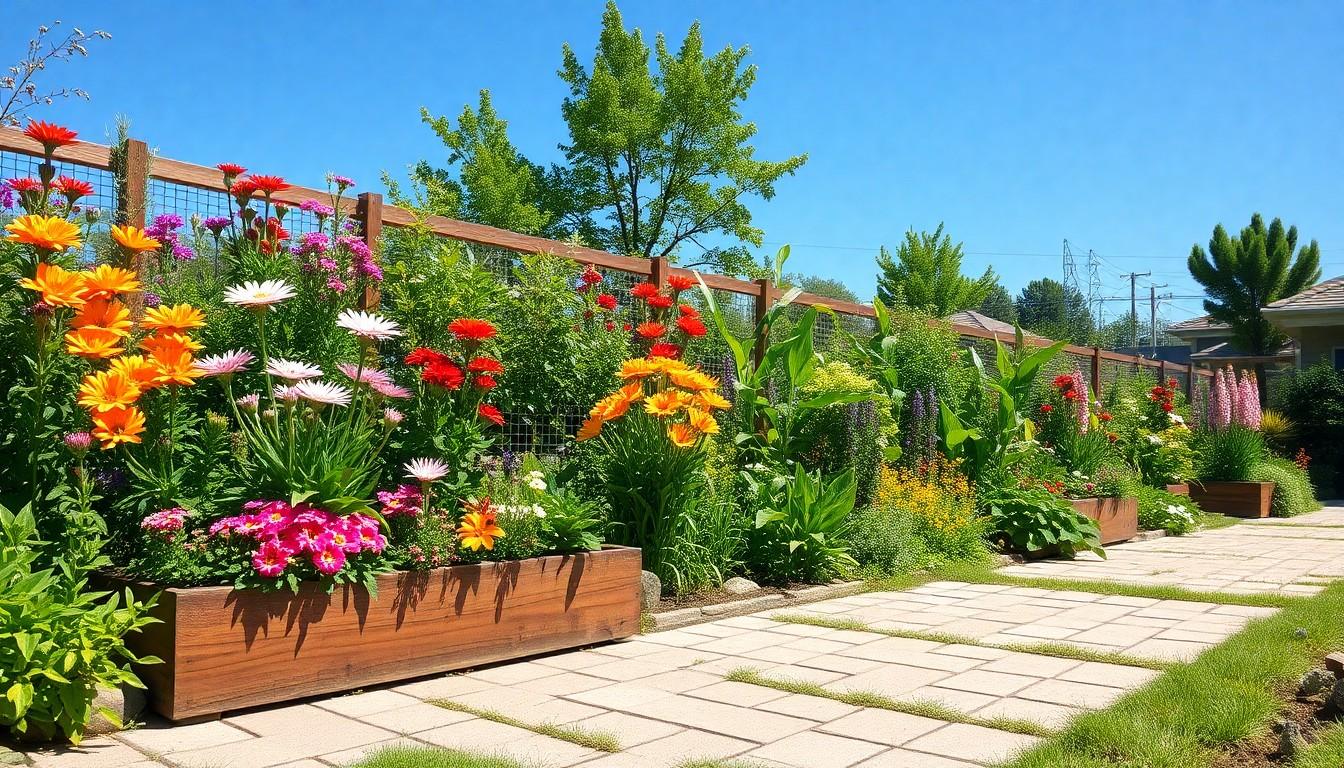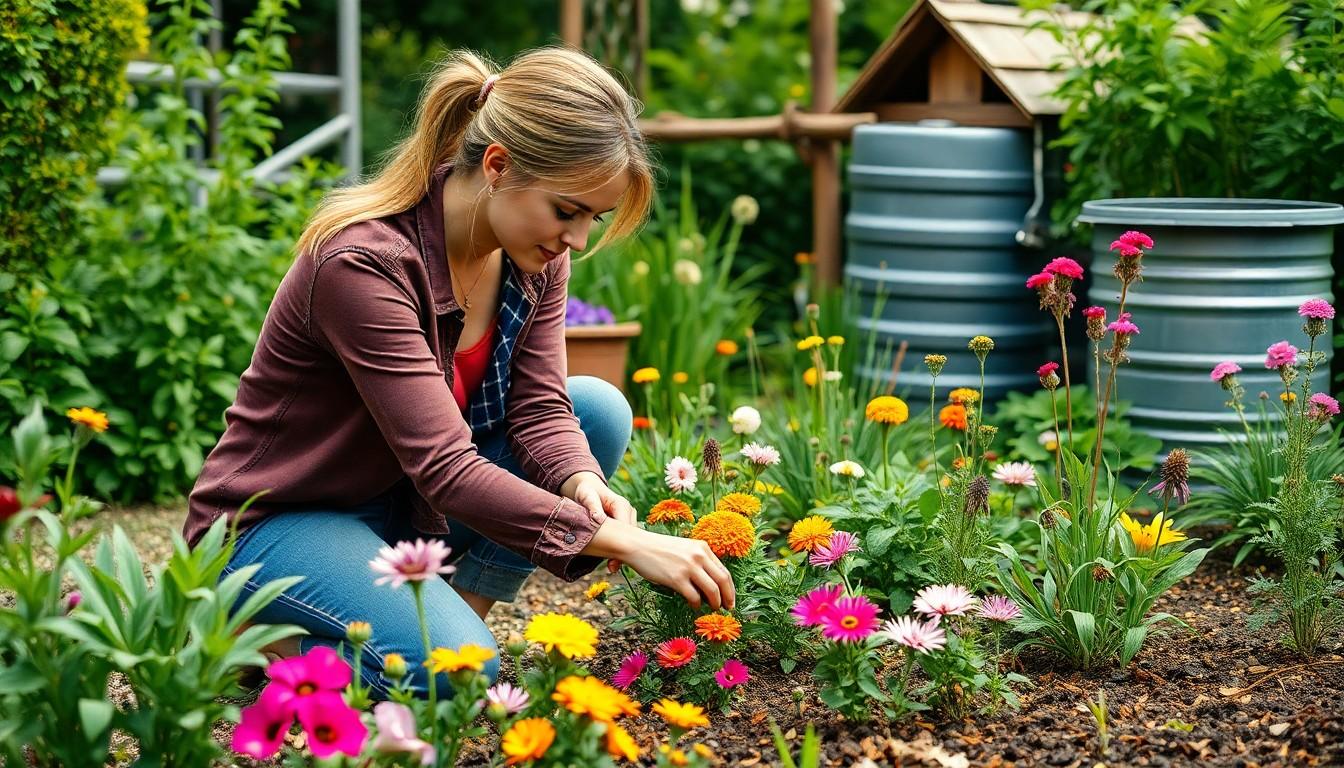Imagine stepping into a garden that not only delights the senses but also plays nice with Mother Nature. Sustainable garden design does just that, blending beauty with eco-friendliness. It’s the ultimate win-win: you get a stunning outdoor space while nurturing the planet. Who knew saving the Earth could be so stylish?
Sustainable Garden Design
Sustainable garden design focuses on creating landscapes that harmonize with the environment. It incorporates practices that minimize resource consumption while enhancing biodiversity. Essential elements include native plants, which require less water and maintenance, and organic gardening techniques that promote soil health.
Water conservation techniques play a critical role. Rain barrels, porous paving, and drip irrigation systems ensure efficient water use. These practices not only preserve water but also reduce runoff, protecting local waterways.
Soil health is another vital aspect. Implementing composting and mulching enriches the soil and supports healthy plant growth. Additionally, crop rotation and companion planting increase nutrient availability, reduce pests, and promote ecological balance.
Wildlife-friendly features enhance the garden’s sustainability. Planting pollinator gardens attracts bees and butterflies, essential for local ecosystems. Providing habitats through birdhouses or native shrubs encourages beneficial wildlife, which naturally controls pests.
Lastly, the design process itself promotes sustainability. Utilizing recycled materials for pathways and structures reduces waste and resource demand. Structuring the garden layout to improve energy efficiency also maximizes sunlight and air circulation, contributing to a healthier environment.
Sustainable garden design integrates multiple elements that work together to reduce environmental impact while fostering beauty and biodiversity. Each choice within the garden contributes to a broader goal of ecological responsibility.
Principles of Sustainable Garden Design

Sustainable garden design embraces practices that support environmental health and promote biodiversity. Key principles include the careful selection of materials and plants that align with this vision.
Eco-Friendly Materials
Sustainable gardening employs eco-friendly materials that minimize harm to the environment. Recycled materials, such as reclaimed wood and repurposed bricks, contribute to resource conservation. Non-toxic paints and finishes in garden structures maintain safety for plants and wildlife. Additionally, using permeable paving allows water to drain naturally, reducing runoff and erosion. Organic mulch, like straw or wood chips, enhances soil health while suppressing weeds. Choosing sustainable materials reflects a commitment to reducing environmental impact.
Native Plant Selection
Native plant selection plays a vital role in sustainable garden design. These plants thrive in local conditions, requiring less water and maintenance. Incorporating native species supports local wildlife, particularly pollinators like bees and butterflies. They create habitats that enhance biodiversity and strengthen the ecological community. Native plants co-evolve with local insects and animals, fostering resilience against pests and diseases. Choosing local flora ensures adaptability, beauty, and environmental compatibility in garden ecosystems.
Benefits of Sustainable Garden Design
Sustainable garden design offers numerous benefits that enhance both the environment and aesthetic value. Gardens designed with sustainability in mind contribute positively to local ecosystems.
Environmental Impact
Sustainable gardens significantly reduce carbon footprints. They utilize native plants that require less water, supporting water conservation efforts. Organic gardening practices foster soil health, minimizing the need for chemical fertilizers. Pollinator-friendly features attract beneficial insects, promoting biodiversity and supporting local wildlife. Implementing efficient water use systems, such as rain barrels, lowers runoff and preserves resources. Recycling materials for garden structures lessens waste generation and reduces environmental harm. Overall, the cumulative effect of these practices boosts environmental health.
Aesthetic Appeal
Sustainable garden design offers visual richness through diverse plant selection. Colorful native plants create vibrant landscapes that thrive in local conditions. Unique plant combinations enhance visual interest while supporting ecological balance. Garden structures made from reclaimed materials blend seamlessly into natural surroundings, adding character. Thoughtful layouts prioritize harmony with the environment, drawing attention and admiration. Seasonal changes bring continuous beauty, with plants flourishing throughout the year. Engaging designs attract visitors, inviting them to appreciate nature’s splendor.
Techniques for Implementing Sustainable Garden Design
Sustainable garden design utilizes various techniques that promote environmental harmony. Methods focus on efficient resource use and fostering biodiversity.
Water Conservation Methods
Rain barrels capture runoff, offering a sustainable water source for gardens. Drip irrigation systems deliver water directly to plant roots, minimizing evaporation and runoff. Mulching retains moisture in the soil, reducing water loss and competing weeds. Grouping plants with similar water needs further enhances efficient irrigation practices. Integrating native plants also contributes to reduced water requirements, as these species adapt well to local conditions.
Soil Health Practices
Composting enriches soil with organic matter, boosting nutrient availability. Mulching, when applied, protects soil from erosion while retaining moisture. Crop rotation diversifies nutrient uptake and minimizes pest buildup, promoting a balanced ecosystem. Companion planting fosters beneficial relationships among species, enhancing overall garden health. Adopting cover crops during off-seasons prevents soil depletion, ensuring long-term fertility and productivity.
Challenges in Sustainable Garden Design
Sustainable garden design faces various challenges that can affect its implementation and effectiveness.
Climate Considerations
Climate variations impact plant selection and garden design. Regions with extreme temperatures require drought-resistant plants that can withstand harsh conditions. Gardeners must evaluate local climate patterns, including precipitation and sunlight, when choosing species. Microclimates within a garden can influence plant adaptability, making it essential to analyze shading and wind exposure. Adapting design strategies for seasonal fluctuations enhances resilience, ensuring plants thrive throughout the year. Understanding these climate variables promotes successful sustainable garden practices.
Maintenance Requirements
Maintenance can present challenges in sustainable garden design. Native plants typically demand less upkeep, yet some may require occasional pruning or weeding. Composting processes need regular attention to ensure decomposition and nutrient availability. Mulching helps reduce weed growth but should be replenished periodically for effectiveness. Efficient garden layouts minimize labor but still require periodic assessments for plant health and vitality. Balancing maintenance efforts with sustainability goals promotes an enjoyable gardening experience while upholding ecological responsibility.
Beauty and Ecological Responsibility
Sustainable garden design offers a harmonious blend of beauty and ecological responsibility. By embracing native plants and eco-friendly practices, gardeners can create spaces that not only please the eye but also support local ecosystems. The integration of water conservation techniques and soil health practices ensures that these gardens thrive with minimal resource consumption.
As more people recognize the importance of sustainability, the movement toward greener gardens continues to grow. This approach not only enhances outdoor aesthetics but also contributes to a healthier planet. With careful planning and thoughtful choices, anyone can cultivate a sustainable garden that reflects their values and nurtures the environment.

